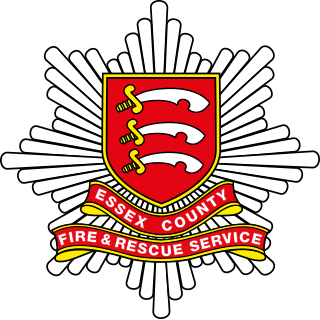
Chemical, biological, radiological and nuclear defense or NBC protection is protective measures taken in situations in which chemical, biological, radiological or nuclear hazards may be present. CBRN defense consists of CBRN passive protection, contamination avoidance, and weapons of mass destruction mitigation.

The Singapore Civil Defence Force (SCDF) is a uniformed organisation in Singapore under the Ministry of Home Affairs that provides emergency services such as firefighting, technical rescue, and emergency medical services, and coordinates national civil defence programme.

The London Fire Brigade (LFB) is the fire and rescue service for London, the capital of the United Kingdom. It was formed by the Metropolitan Fire Brigade Act 1865, under the leadership of superintendent Eyre Massey Shaw. It has 5,992 staff, including 5,096 operational firefighters and officers based at 102 fire stations.
The Metropolitan Fire Brigade (MFB), also known as the Metropolitan Fire and Emergency Services Board, was a fire service in Victoria, Australia. The MFB provided firefighting, rescue, medical and hazardous material incident response services to the metropolitan area of Melbourne. The MFB's headquarters were located at the Eastern Hill Fire Station in East Melbourne.

The Fire Service College is responsible for providing leadership, management and advanced operational training courses for senior fire officers from the United Kingdom and foreign fire authorities. It is located at Moreton-in-Marsh in Gloucestershire, England. It has been owned by Capita since February 2013, having previously been an executive agency and trading fund of the Department for Communities and Local Government.

The fire services in the United Kingdom operate under separate legislative and administrative arrangements in England and Wales, Northern Ireland, and Scotland.

The UK Government Decontamination Service is an organisation within the UK Government that provides advice and guidance to help the UK resist and recover from any deliberate or accidental release of chemical, biological, radiological or nuclear materials (CBRN) or from major accidental releases of hazardous materials (HAZMAT).

Devon and Somerset Fire and Rescue Service (DSFRS) is the statutory fire and rescue service covering the county of Devon and the unitary authorities of Plymouth, Torbay) and Somerset in South West England – an area of 3,924 square miles (10,160 km2). It serves a population of 1.75 million, and is the fifth largest fire and rescue service in the United Kingdom.

Essex County Fire and Rescue Service (ECFRS) is the statutory fire and rescue service for the county of Essex in the east of England, and is one of the largest fire services in the country, covering an area of 1,338 square miles (3,470 km2) and a population of over 1.7 million people.

Dumfries and Galloway Fire and Rescue Service was the statutory fire and rescue service for the area of Dumfries and Galloway, Scotland. It was amalgamated into the single Scottish Fire and Rescue Service in 2013.

Central Scotland Fire and Rescue Service was the statutory fire and rescue service for the area of Central Scotland, Scotland between 1975 and 2013. It was amalgamated into the single Scottish Fire and Rescue Service in 2013.

Tayside Fire and Rescue Service was, between 1975 and 2013, the statutory fire and rescue service for the area of Tayside in Scotland. It was amalgamated into the single Scottish Fire and Rescue Service in 2013.

Hertfordshire Fire and Rescue Service (HFRS) is the statutory fire and rescue service for the county of Hertfordshire, England. HFRS covers an area of 1,514 square miles (3,920 km2) and a population of 1.19 million.

Cornwall Fire and Rescue Service is the statutory fire and rescue service covering Cornwall, England. As of April 2019, the service employs over 400 retained firefighters, 203 full-time firefighters, plus 170 support and administrative staff. Created under the Fire Services Act 1947 as "Cornwall Fire Brigade", the name changed to "Cornwall Fire and Rescue Service" on 1 October 2009.
Firelink or FireLink is a wide area radio system in England, Wales, and Scotland for fire services. The system which supports both voice and data communication was designed to replace a patchwork of analogue systems with a modern wider area digital system. It provides new functionality – notably resilience and interoperability with other FRS and emergency services - which previous major incidents have identified as important.

Norfolk Fire and Rescue Service (NFRS) is the statutory fire and rescue service for the county of Norfolk in the east of England. The county consists of around 870,100 people, covering the 4th largest area in England with 2,074 square miles including 200 miles of inland waterways, 90 miles of coastline and 6,125 miles of roads. The county city is Norwich with other major towns including Great Yarmouth, King's Lynn and Thetford. Norfolk has one of the 20 Urban Search and Rescue teams across England and Wales which were set up in response to the 9/11 attacks. The teams, including Norfolk, have the capacity to deal with two simultaneous incidents across the UK.

Fire services in the United Kingdom use a variety of fire appliances, which perform a wide range of general and specialised roles and fit into several distinct categories. Contemporary fire appliances carry a multitude of equipment and firefighting media to deal with different types of emergencies ranging from fires, rescues, vehicle extrication, floods, salvage, casualty and trauma care.
The Hazardous Area Response Team (HART) is a capability of the NHS ambulance services in the United Kingdom devoted to providing paramedic and enhanced medical care to patients in the "hot zone" of hazardous environments.

The Scottish Fire and Rescue Service is the national fire and rescue service of Scotland. It was formed by the merger of eight regional fire services in the country on 1 April 2013. It thus became the largest fire brigade in the United Kingdom, surpassing the London Fire Brigade.

The Isle of Man Civil Defence Corps is one of the five emergency services maintained by the Isle of Man Government, to provide a range of emergency responses on the Isle of Man, an independent Crown dependency located in the Irish Sea between England and Ireland. The Corps operates under the Department of Home Affairs.


















